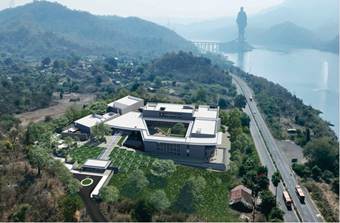Foundation Stone Laid for the Museum of Royal Kingdoms of India at Ekta Nagar, Gujarat

IN NEWS
Foundation Stone Laid for the Museum of Royal Kingdoms of India at Ekta Nagar, Gujarat
Analysis
- On the occasion of Rashtriya Ekta Diwas (31 October 2025), Prime Minister Narendra Modi laid the foundation stone for the Museum of Royal Kingdoms of India near the Statue of Unity in Ekta Nagar, Gujarat.
- The museum, with an estimated cost of ₹367 crore, will be constructed on five acres of land, symbolising the enduring spirit of unity, sacrifice, and heritage.
- It will feature four thematic galleries designed to showcase India’s royal legacies, artefacts, and documents, blending traditional heritage with digital innovation.
- The project aims to inspire future generations by narrating the journey from princely kingdoms to a united India, aligning with the vision of “Ek Bharat, Shreshtha Bharat.”
- The initiative commemorates India’s political integration, achieved under Sardar Vallabhbhai Patel’s leadership, which united over 550 princely states post-Independence through the Instrument of Accession.
- The museum will serve as a national repository for regalia, textiles, paintings, manuscripts, and archival materials reflecting India’s royal history and contribution to unity.
- It also intends to promote interactive and experiential learning, inspired by the National Education Policy (NEP) 2020, making history more engaging and accessible.
- Architecturally, the museum will harmonise with the natural surroundings of Ekta Nagar, incorporating water bodies, gardens, courtyards, and fountains to reflect India’s royal aesthetics.
- Visitors will traverse from royal garden-inspired landscapes to immersive galleries, culminating their experience at a Museum Café serving royal cuisine.
Key Features and Gallery Overview
- Gallery 1 – Orientation Gallery:
- Introduces visitors to India’s royal history through films, interactive displays, and audio-visual narratives.
- Gallery 2 – “The Throne and the State”:
- Highlights governance systems, welfare traditions, and people-centric policies of royal families.
- Includes a Viewing Lounge and Deck overlooking the Statue of Unity and Narmada River.
- Gallery 3 – “The Story of India’s Integration”:
- Chronicles the events and documents related to the political integration of princely states post-1947.
- Gallery 4 – “Hall of Unity”:
- Displays symbols and insignias of princely states, honouring their role in India’s unity and nation-building.
Objectives of the Museum
- Preserve and document the legacies of India’s royal and princely states.
- Educate and engage the public about the integration process and contribution of royal houses.
- Promote research and cultural understanding of India’s regal and democratic evolution.
- Encourage national pride through narratives of unity, governance, and cultural synthesis.
Historical Context
- At Independence in 1947, India consisted of British-administered territories and 550+ princely states.
- Sardar Vallabhbhai Patel and V.P. Menon played pivotal roles in persuading princely rulers to accede to India.
- By 1949, almost all states had joined the Union, marking the peaceful political unification of India.
- The museum will immortalise this achievement, reinforcing India’s unity in diversity as a cornerstone of its democratic identity.
Static Pointers
- Location: Ekta Nagar, Gujarat (near the Statue of Unity)
- Estimated Cost: ₹367 crore
- Total Area: 5 acres
- Total Galleries: 4 thematic galleries
- Associated Personality: Sardar Vallabhbhai Patel – Architect of India’s Political Integration
- Policy Inspiration: National Education Policy (NEP) 2020
- Significance Day: Rashtriya Ekta Diwas – observed on 31st October to commemorate Patel’s birth anniversary
Updated – 31 Oct 2025 ; 12:48 PM | PIB
Source:PIB Delhi